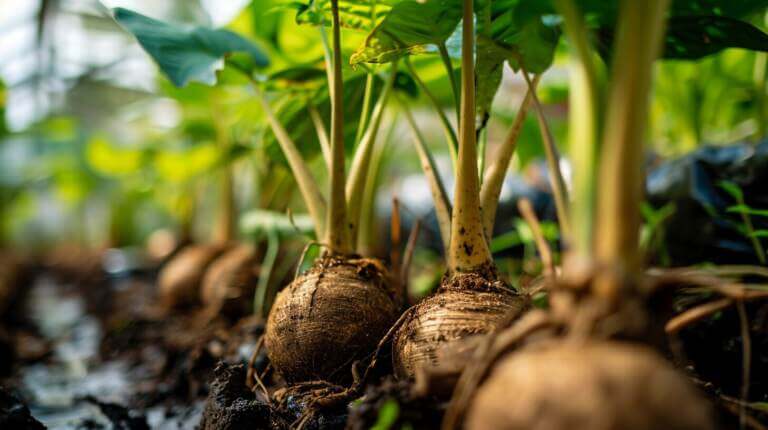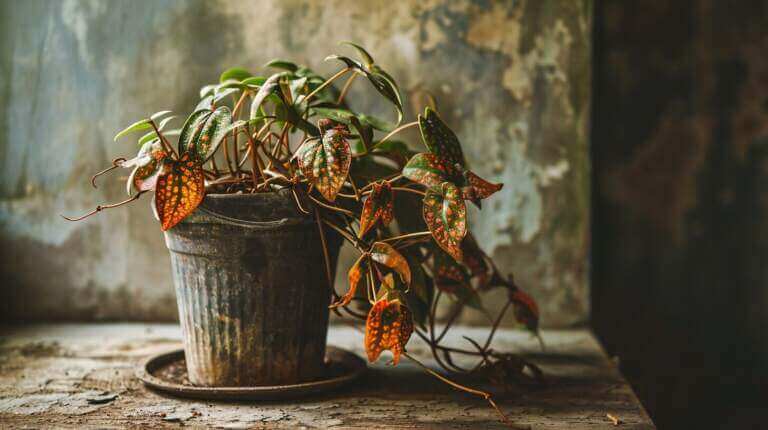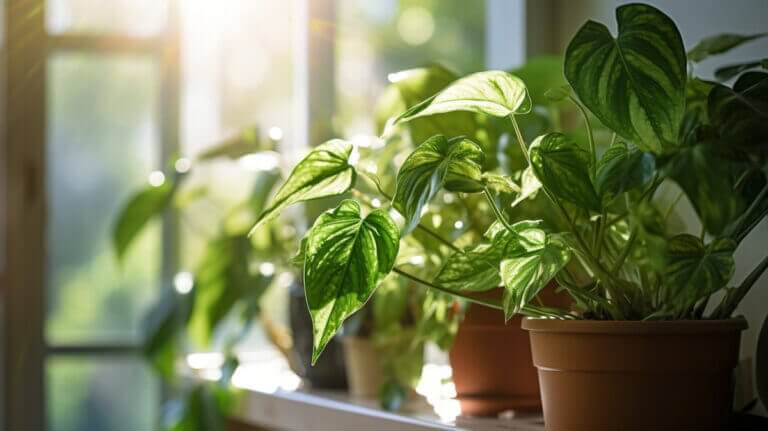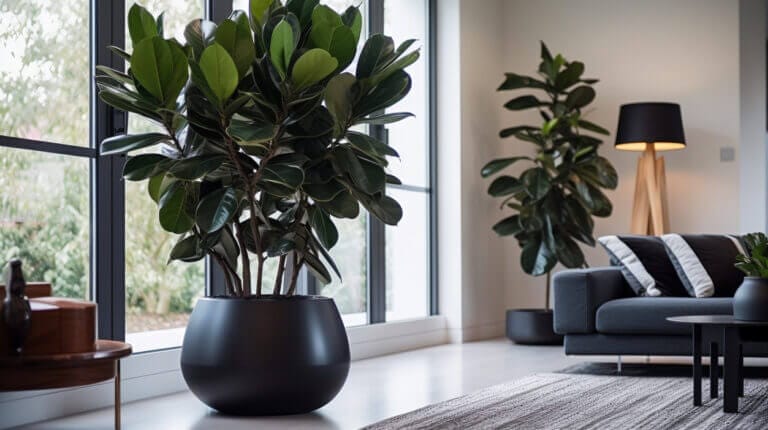Nerve Plant (Fittonia Albivenis) Care Guide: Soil, Light, and Water Requirements Explained
Welcome to my guide on demystifying Fittonia care! If you’re a plant enthusiast looking to grow and nurture this delicate houseplant, it’s essential to understand its specific soil, light, and water requirements. Fittonia, also known as the nerve plant, is a popular choice for indoor gardening due to its vibrant foliage and unique patterns. By providing the right care, you can ensure that your Fittonia thrives and adds beauty to your home or office space.
Key Takeaways:
- Fittonias require high humidity levels to thrive, between 70% and 90%.
- Regular watering is crucial, but be careful not to overwater and cause root rot.
- Creating a humid environment through the use of humidifiers, humidity trays, or terrariums can help maintain ideal moisture levels.
- Fittonias prefer medium to low light conditions and should be protected from direct sunlight.
- Well-draining potting soil is essential to prevent waterlogged roots.
Understanding Fittonia’s Moisture Needs
Proper moisture management is crucial for the health and vitality of fittonia plants. These vibrant houseplants thrive in high humidity environments, typically between 70% and 90%. When the air becomes dry, fittonias are prone to wilting, which can negatively impact their overall growth and appearance. Therefore, it is essential to pay close attention to their watering needs.
The frequency of watering fittonias depends on various factors such as temperature, humidity, and the size of the pot. As a general guideline, it is recommended to check the soil moisture regularly and water when it feels slightly dry to the touch. During the heating season, when indoor air tends to be drier, watering fittonias about twice a week is usually sufficient. However, it is crucial to avoid overwatering, as excessive moisture can lead to root rot and other issues.
When watering fittonias, it is best to use room temperature water to prevent shocking the plant. This can be achieved by filling a watering can in advance and allowing it to sit for a few hours. Pour the water onto the soil until it starts to drain out of the bottom of the pot, ensuring thorough hydration. Remember to discard any excess water from the drainage tray to avoid waterlogging the roots. By maintaining a proper watering routine, fittonias can thrive and display their stunning foliage to their full potential.
Table: Fittonia Watering Guidelines
| Indoor Temperature | Watering Frequency |
|---|---|
| 65-75°F (18-24°C) | Water about twice a week |
| Above 75°F (24°C) | Water more frequently, as needed |
| Below 65°F (18°C) | Reduce watering frequency |
Keep in mind that these watering guidelines serve as general recommendations. It’s important to monitor the specific conditions of your fittonia plants and adjust the watering frequency accordingly. Always observe the moisture level of the soil and the appearance of the plant to ensure it receives the appropriate amount of hydration.
Creating a Humid Environment for Fittonia
Proper humidity is essential for the health and growth of fittonia plants. These tropical beauties thrive in high humidity levels, typically ranging between 70% and 90%. To provide the necessary humidity for your fittonia, there are several methods you can try:
- Use a Humidifier: Placing a humidifier in the room where your fittonia is located is an effective way to increase moisture levels. The humidifier will add moisture to the air, creating a more humid environment for your plant.
- Utilize a Humidity Tray: A humidity tray is a shallow tray filled with water that you can place beneath your fittonia’s pot. As the water evaporates, it increases the humidity around the plant. Be sure to keep the water level below the pot’s bottom to avoid waterlogged soil.
- Grow in a Terrarium: Another option is to grow your fittonia in a terrarium. A terrarium acts as a mini greenhouse, trapping moisture and creating a humid microclimate. Choose a clear glass container with a lid to retain humidity.
Tip: Covering your fittonia with a transparent dome, like a plastic bag or a bell jar, can also create a greenhouse-like environment that helps retain humidity.
It’s important to monitor the humidity levels regularly, especially in dry indoor environments. If the humidity drops below the optimal range, consider implementing one or more of these methods to create a humid environment for your fittonia.
Table: Comparison of Humidity Methods for Fittonia Care
| Method | Advantages | Disadvantages |
|---|---|---|
| Humidifier | – Provides consistent humidity – Suitable for larger spaces | – Requires regular maintenance – Additional cost |
| Humidity Tray | – Easy to set up – Cost-effective | – Requires manual monitoring – Potential for water overflow |
| Terrarium | – Creates a self-contained humid environment – Visual appeal | – Limited space for plant growth – Requires proper ventilation |
By implementing these humidity methods, you can ensure that your fittonia is provided with the optimal moisture levels it needs to thrive. Regularly monitor the humidity and adjust the methods as necessary to maintain a healthy and vibrant fittonia plant.
Finding the Right Light Conditions for Fittonia
Proper lighting is crucial for the health and growth of fittonia plants. Understanding their light requirements will help you provide the ideal conditions for these delicate houseplants.
Fittonia Care Light Requirements:
- Fittonias prefer medium to low light conditions.
- Direct sunlight can scorch their delicate leaves, so it’s important to keep them away from blazing summer sun.
- Place the plant in a spot where it receives bright, indirect light.
Indoor lighting can play a key role in providing adequate light for fittonia plants. If your home doesn’t receive sufficient natural light, you can supplement it with artificial light sources such as LED or fluorescent lights. These can be positioned near the plant to ensure it receives the required light levels.
Remember to monitor your fittonia plant closely once you’ve adjusted the lighting conditions. If you notice any changes in leaf color, such as browning or yellowing, it may indicate that the light levels are too high or too low. Adjust the positioning of the plant accordingly to achieve the optimal lighting balance.
| Light Conditions | Characteristics |
|---|---|
| Medium to Low Light | Ideal for fittonia plants |
| Direct Sunlight | Avoid to prevent leaf scorching |
| Bright Indirect Light | Position fittonia plants to receive this type of light |
By providing the right light conditions, you can help your fittonia plant thrive and showcase its vibrant foliage. Remember to balance the lighting needs with the other care requirements, such as humidity and watering, to create an optimal environment for these beautiful houseplants.
Choosing the Right Soil for Fittonia
One of the key factors in successfully caring for a Fittonia plant is choosing the right soil. Fittonias thrive in well-draining potting soil that allows excess water to flow out easily, preventing the roots from becoming waterlogged. This helps to prevent root rot, which can be detrimental to the health of the plant.
A suitable potting mix for Fittonias should include ingredients that improve drainage, such as perlite or orchid bark. These additives help to create air pockets in the soil, allowing for better circulation and preventing water from pooling around the roots. It’s important to avoid using regular garden soil, as it tends to be too heavy and can retain excessive moisture, leading to root rot.
When repotting a Fittonia, it’s recommended to use fresh potting soil. This ensures that the plant has access to the necessary nutrients and proper drainage from the start. If the plant has outgrown its current pot, choose a container that is slightly larger and fill it with the appropriate potting mix.
| Soil Requirements for Fittonia |
|---|
| Well-draining potting mix |
| Includes perlite or orchid bark for improved drainage |
| Avoid regular garden soil |
| Repot into fresh potting soil for proper drainage and nutrient availability |
By selecting the right soil for your Fittonia plant, you can provide it with the optimum growing conditions it needs to thrive. Remember to choose a well-draining potting mix that includes perlite or orchid bark, and avoid using regular garden soil. Repotting into fresh soil when necessary will help to ensure proper drainage and nutrient availability for your Fittonia.
Fertilizing and Pruning Fittonia
Fertilizing and pruning are important aspects of fittonia care that can help promote healthy growth and maintain the plant’s appearance. By providing the right nutrients and shaping the plant, you can ensure your fittonia thrives in its environment.
Fertilizing Fittonia
Proper fertilization is essential for the overall health of your fittonia. During the growing season, which typically spans spring and summer, it’s recommended to fertilize the plant every four to six weeks. Using a balanced liquid fertilizer, follow the dosage instructions provided on the packaging. Over-fertilization can harm the plant, so be careful not to exceed the recommended amount.
When applying the fertilizer, make sure the soil is moist, but not waterlogged. This helps prevent the roots from burning. Fertilize the plant by pouring the liquid directly onto the soil, avoiding contact with the foliage to prevent leaf burn. It’s important to remember that fittonias are sensitive to mineral salts, so always use a diluted fertilizer and flush the soil occasionally to remove any build-up.
Pruning Fittonia
Pruning fittonias helps maintain their compact shape and encourages bushier growth. It also helps prevent the plant from becoming leggy or bare in the middle over time. Pruning fittonias is relatively simple and can be done by pinching or cutting back the stems.
Pinching involves removing the tips of the stems, which prompts the plant to grow new branches and foliage. To pinch a fittonia, use your fingers or clean pruning shears to snip off the top few inches of the stem. This can be done whenever the plant becomes too long or starts to lose its fullness.
When cutting back the stems, make sure to do so just above a leaf node. This will encourage new growth from that point. Regular pruning not only keeps the fittonia looking tidy but also helps it redirect its energy into producing new leaves and stems.
| Fertilizing Tips | Pruning Tips |
|---|---|
|
|
Troubleshooting Fittonia Care Issues
When caring for Fittonia plants, it’s important to be aware of common issues that may arise. By understanding potential problems and their solutions, you can ensure the health and vitality of your plant.
Pest Infestations
Fittonias can be susceptible to pests like spider mites and aphids. These tiny insects can cause damage to the leaves and hinder the plant’s growth. Regular inspection is recommended to catch any infestations early. If you notice pests, you can try using organic insecticidal soap or neem oil to control them. Be sure to follow the instructions on the product for safe and effective application.
Yellowing Leaves
If you observe yellowing leaves on your Fittonia, it may be a sign of various issues. Overwatering can cause root rot, leading to yellowing foliage. Ensure that you are not overwatering and that the soil has proper drainage. Alternatively, yellowing leaves can also be a result of too much direct sunlight. Move your plant to a spot with indirect light to prevent further yellowing.
Adjusting Care Routine
If you’re experiencing persistent issues with your Fittonia, it may be necessary to adjust your care routine. Every plant is unique, and some may have specific needs. Consider factors such as humidity levels, watering frequency, and light conditions. Trial and error can help you find the optimal care routine for your Fittonia. If problems persist, consulting a plant expert can provide valuable insight and guidance.
FAQ
When should I repot my fittonia plant?
You should repot your fittonia plant as soon as the soil feels dry to the touch. This plant needs a pot with drainage holes to prevent waterlogging.
What type of fertilizer is best for fittonia plants?
A balanced fertilizer with equal parts nitrogen and phosphorus is ideal for fittonia plants. It provides the right balance of nutrients to boost their growth.
Why is fittonia often referred to as a paradise plant?
Fittonia is often referred to as a paradise plant because of its captivating allure. Its vibrant leaves and intricate patterns make it a botanical paradise.
What are the watering needs of a fittonia plant?
Fittonia plants prefer their soil to be consistently moist but not soggy. Waterings should be done with tepid water when the top layer of soil begins to dry out.
How do I care for a fittonia seedling?
Fittonia seedlings are fragile and need a humid environment to flourish. Keep them in a clear plastic container to maintain higher humidity and mist them regularly.
How does a fittonia plant adapt to indoor conditions?
Fittonia plants often adapt well to indoor conditions. They can thrive in indirect light and prefer a humid environment, which can be achieved by regular misting.
How do I get my fittonia plant to bloom?
Fittonia plants can bloom when they are in the right conditions. They need indirect light, consistent moisture, and a boost of fertilizer during the fall and winter.
How do I maintain the upright growth of my fittonia plant?
To maintain the upright growth of your fittonia plant, ensure it has enough light. Rotate the plant regularly to encourage even growth.
How do I care for a fittonia plant in the long term?
Long-term care for a fittonia plant involves regular watering, indirect light, and occasional fertilizing. The plant also benefits from being repotted every few years to refresh the soil.







